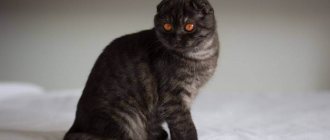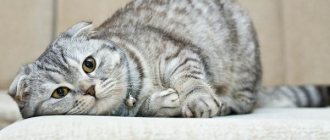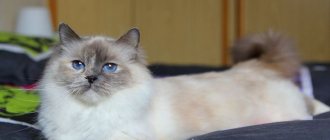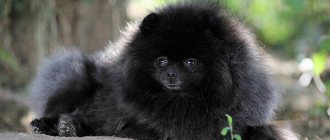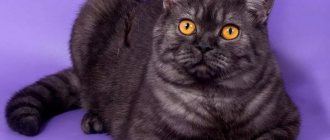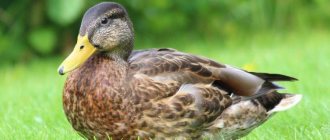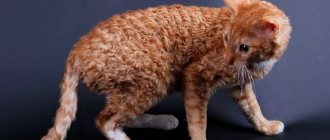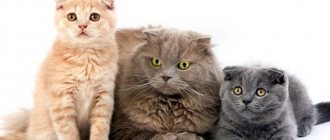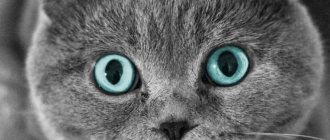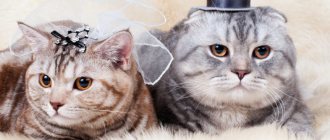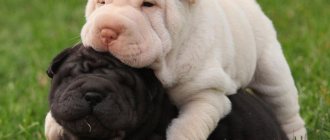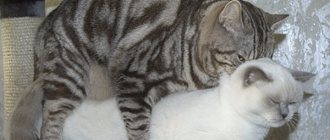Scottish Fold cats are considered popular due to their unusual appearance. Their appearance is so bright that you definitely won’t confuse them with other breeds. They resemble a baby owl - on a neat round head, ears are almost invisible and large round eyes. The breed takes its roots in Scotland, where a certain William Ross bought a cat with an unusual appearance at the market in 1961 and named her Susie. It was she who later became the ancestor of the breed, which, after a series of crossings, acquired many colors and characteristic features.
The first cats of this breed did not have a very representative appearance, but after they were crossed with the British smooth-haired breed, the situation changed dramatically for the better. In 1966, the Scottish Fold or Scottish Fold breed was officially recognized as an independent breed.
The path to recognition of Scottish folds was not easy. In 1971, it was discovered that the gene that gives such an unusual drooping shape to the ears often leads to deafness in kittens, as well as to the fusion of their vertebrae, so geneticists began to prohibit the breeding of this breed. But photographs of these animals have already spread throughout the world and won the hearts of lovers of unusual cats.
[advertising]
Therefore, many countries began to look for ways to eliminate this problem. As a result, the solution was found, it will be written about below. Fortunately, it is now possible to breed healthy offspring and the popularity of this breed continues unabated.
Description of breed standards:
- a medium-sized body, squat and stocky, with dense bones and a voluminous chest, a wide back and massive hips, weight from 4 to 7 kg;
- the neck is not long and powerful;
- the tail is of medium length, flexible, tapering at the end;
- the head is round with noticeable rounded cheeks;
- the limbs are not long, muscular and thick, reminiscent of the legs of a plush toy, the paws are round and large;
- the eyes are huge and round, the color can be yellow and green;
- the nose is short, smoothly turning into a powerful chin;
- the ears are small in size and have one or two bends; they almost completely cover the auricle, are set far apart, and turn forward;
- the coat is short, dense and soft, reminiscent of plush, the color can be different.
Character of the Scottish Scottish Fold
This cat breed loves home very much. They are strongly attached to their place. However, walking in the fresh air won't hurt. Cats become very attached and sensitive.
- If the owner is absent for a long time, the Scottish Fold will be upset and this can lead to depression. Kittens and young cats are especially vulnerable.
- They are calm, balanced, affectionate and patient. You can't expect aggression from this breed. Cases of such behavior are very rare.
- For them, the solution to any conflict is to ignore the offender. This cat is also suitable for families with children.
She will not mind attention to her person, but if there is too much pestering, she will simply leave. A cat can make a sound, but it is not very similar to meowing. In the photo, the Scottish Fold looks very cute; his ears make his eyes stand out more.
Care and maintenance
If you decide to purchase a pet such as a Scottish Fold , first arrange for a cat. It is necessary to buy a tray, food and toys in advance so that the baby can immediately adapt to the new place.
The list of mandatory care measures includes:
- Combing. Use a stiff or wire brush. Comb several times, both with and against the coat. These cats love to be brushed against the grain.
- Ears. Clean them carefully at least once a week. They sometimes have excessive sulfur output, which must be removed.
- Eyes. Lightly wipe your eyes with the end of a cotton pad soaked in boiled water once a week.
- Claws. They often know how to use a scratching post. But if you are not accustomed, try to trim once a month.
The animals are not usually sickly, but they do have genetic problems. Bone diseases are the most common. Moreover, these sores can occur at any age - the skeleton may become deformed, the tail may become inactive, or the limbs will begin to thicken. This is called osteochondrodysplasia.
If you notice a change in your pet’s gait, see that he reacts painfully to touching his tail, has no desire to jump, or has a squat appearance in his figure, contact your veterinarian immediately.
It is necessary to monitor the pet's health. In addition, they are susceptible to heart disease, bronchitis, and diabetes. These diseases are not congenital, and also require timely diagnosis and treatment.
Cat care
To clean your ears you will need:
- Cotton swabs, swabs and cotton pads;
- Ear cleaning lotion;
- Things or fabric in which the animal is wrapped in a roll so that it resists less and calmly allows the ear to be cleaned.
You need to carefully turn out the ear after wrapping the cat in something, for example, a robe. A cotton pad is soaked in lotion and wiped over the ear. After this, wipe the ear with a cotton swab so that no liquid remains.
Next, cotton swabs are used, but they must be handled with extreme caution. They can injure the eardrum. It is recommended not to press too hard on the auricle so as not to injure it.
Origin story
The history of the Scottish Fold breed began in the mid-20th century in Scotland. On one of the farms, the cat Susie was born: the tips of her ears were curved not up, but down, which gave her face a surprised and funny expression. Susie herself had children like this from time to time. And, quite possibly, they would have remained to live and die on the farm if they had not accidentally caught the eye of a British cat breeder in 1963.
Mary Ross (that was the name of the breeder) immediately realized that this was not just a physical defect, and began to work on a new breed. As a result of mating with a British blue cat and a British shorthair kitten, kittens were born - the first representatives of the Scottish Fold.
A specific gene is responsible for lop ears - Fd. If it is present in both parents, their offspring will face serious problems with the musculoskeletal system and early death. But experimentally it turned out that mating with a Scottish Shorthair - Scottish Straight - allows you to have kittens with desirable external characteristics, but without serious health pathologies.
The Scottish Fold breed was registered in 1994.
Eye wash
Cats of this breed are prone to excessive tearing, which causes discharge to accumulate on the fur. They need to be removed. Owners often use weak tea leaves for this.
- A cotton pad is dipped and passed from the outer corner towards the bridge of the nose.
- If you are unable to remove all the discharge the first time, repeat the procedure with a new cotton pad and liquid.
Bathing is carried out once every few months. These cats take bathing calmly, but it is better to accustom cats to this from childhood, when they are still kittens. The use of human shampoos or conditioners is not recommended.
There are special shampoos for animals that can be purchased at any pet store. There are also special shampoos for various parasites that can live on your pet’s skin.
Bathing recommendations:
- Before bathing, you need to plug your cat's ears with cotton to prevent water from getting into them;
- Using a hose may frighten the cat; it is better to use a shower;
- The water should be slightly warmer than room temperature, about 30-35 degrees Celsius;
- The wool is watered and soaped. Try not to get shampoo in the eyes, this can cause pain to your pet;
- When rinsing off the foam, close the cat's eyes and nose to prevent water from getting into these places;
After bathing, you need to dry your pet and wrap it in something. The cat will be cold if you just let it go.
You can wrap her in a woolen robe or some other warm thing. While the cat is drying, there should be no window open in the room where it is located.
Kinds
It happens that kittens of this breed have ears that remain straight as they age. Then they are called Scottish Straights. Many felinological (“feline” means cat) organizations recognize both of these species as one breed and are presented in the same ring.
The Scottish Straight standard is the same as the folds, except for the ears. In straight-eared animals, they should be small or medium in length, erect with pointed tips. Large at the base and set wide apart. The Scottish Fold color can be divided into several categories:
Classic solid colors, they are called “solid”, which means “strong, stable”:
- The Scottish Fold Black is a true jet black cat. No red tan marks are allowed, this is considered a defect. There may be a couple of white hairs on an anthracite background, but nothing more. A cat with eyes the color of chocolate caramel or dark honey. Very mysterious and effective. In the Scandinavian sagas it can be a companion of a sorceress.
- The Scottish White is a small snowman with bright eyes that can be blue, orange, amber or copper. And they also come in different colors (heterochromia). Kittens have faint spots on their fur; adult cats do not have them.
- Blue (blue color) implies several shades that are considered blue. Some have a color closer to gray, others closer to blue. All hair must be well dyed, then the fur looks the perfect color. Babies may develop small patterns on their fur that disappear after a couple of months. At first, the eyes may have a copper tint, but with age they turn a little yellow.
- Red (fawn) color is not common. A ginger cat from a young age has a color defect - an unevenly colored tail. Sometimes the color goes more red. Animals may have designs on their foreheads, but this is not considered a rule.
- Cream – creamy peach colored fur makes the cat very elegant and gentle. There are patterns on the paws and tail, but not in the form of leopard spots.
- Chocolate Scottish is a rather rare color and looks very beautiful. Kittens have pure chocolate-colored fur; adult cats have a noble bitter-coffee shade.
- Lilac (lavender) Scottish, you can also call it “coffee with milk”. Obtained only from parents of a similar color or. The eyes have all shades of honey - yellow, amber, orange, copper. Nose – beige or light brown.
- Faun (deer) - not to be confused with lilac. The color is a smoky fawn shade, with a chocolate tint on the folds. The nose and paw pads are soft pink.
- Cinnamon Scottish (cinnamon is a variety of cinnamon), the color looks like cocoa with the addition of cinnamon. It differs from chocolate in the bright pink color of its nose and paw pads with a brown tint. The color looks expensive, it is considered so, and it is also very rare.
Bicolor is a color of two colors, one is always white, the other is any of the solid tones. Pedigree cats must have a white face, paws, collar, chest and belly. It is appreciated if the white collar is not closed on the neck, and there is a spot in the form of a white triangle on the muzzle. Eyes of amber shades - bright orange, copper and honey color.
- Particolor (calico) - a combination of white and tortie (tortoiseshell) color, or white and spotted tabby color;
- Harlequin usually captivates at first sight with its elegant colors. The animal has 4/5 white fur, but the tail and ears, as well as the small cap on the head must be black. The belly is white, the nose has a pink tip.
- Van - only the tail is colored, and there are a few small spots on the head. If these spots have a red tint, the cat is called a “red van.” It is common that there are large solid spots on the paws and back, but breeders do not welcome this.
Color point is a rare color similar to the Siamese. On a light tone, darker points stand out - protruding parts of the body: ears, muzzle, tail and legs. The range of colors comes in chocolate, cream, purple, red and blue tones. Scottish cats “borrowed” this color from British cats. The eyes are bright blue, the more contrast, the more valuable.
Colo-point with white is an elite color. These animals look luxurious. In fact, this is a bicolor, only along with the white second shade there is a color-point range. The eyes, as is customary for color-point cats, are blue in different shades.
Ticked. Each hair of a cat's fur is colored in three colors. For example, a black ticked Scottish has light hair at the root, then brown, and black at the top. In this category there are red and blue ticked, black silver. Their eyes are orange-copper or green (usually silver).
Tabby - with bright stripes or spots on a light background. It comes in two types - classic (marbled) and brindle (striped). Kittens may have a pattern of the letter “M” or a butterfly on the back of their heads, and a pattern of rings on their sides, lighter or darker than the background;
Chinchillas are an artificially bred breed with a white undercoat, dark paw pads, and natural “makeup” on the face - a dark border around the eyes, nose and lips. The fur is not long, the colors are ticked and shaded. There are tortoiseshell (only cats), bicolor (expensive colors), smoky (both full and bicolor, van and harlequin). Relatively young breeds are popular - silver chinchilla and golden chinchilla.
Pros and cons of the Scottish Fold
Pros:
- She is calm and friendly;
- Loves attention and affection;
- This breed is quick to toilet train;
- This cat is not hyperactive;
- Adaptation to new conditions occurs quickly;
- Minimal pet care;
- Conflicts with other animals are rare; if they do occur, it is mainly with dogs or rodents.
Minuses:
- Careful care of soft fur;
- Sheds quite heavily;
- Ear cleaning is carried out with a special sprayer, which is designed to prevent the development of inflammatory diseases;
- Prefer variety in diet;
- Balanced proper nutrition;
- Genetic predisposition to urolithiasis.
Price
The cost of a kitten depends on a number of factors - primarily pedigree, necessary documents, hereditary diseases and habits. There are several classes of pedigree kittens.
- Show class is the elite of this breed. Parents participated in exhibitions and received awards. The cost of such a copy is from 1200 to 2500 euros.
- Breeds are proven healthy babies with a decent pedigree and documents. Allowed for exhibitions. The price ranges from 500 to 1000 euros.
- Pets are purebred pets that were disqualified from participation in exhibitions for minor reasons and are not allowed to breed. This is the best choice if you just want to have a furry pet at home and don’t need a show piece. The average price for a Scottish Fold in this category in nurseries ranges from 100 to 500 euros.
It is advisable to choose well-known nurseries and trusted breeders. Do not try to buy on sales sites, although the cost there may be lower. You must receive a guarantee of purebredness and health. Even if it's a little more expensive. There are nurseries in Russia that breed these cats. For example, in Moscow Ermine Trace.
Security
- Bowls for water and food, it is recommended to buy ceramic bowls;
- Tray;
- Cat litter; Brushes for hair and teeth;
- Metal combs;
- Massage glove;
- Cosmetics for pets (shampoos, detanglers, etc.);
- Nail clipper;
- Towels;
- Diapers;
- Toys;
- scratching post;
- House.
When a kitten first gets to a new home, it experiences stress. Therefore, it is recommended to lock the kitten in one room with food bowls and a tray, so that he first looks around there (takes a couple of hours), and then begins to explore new territories. At this point, the best time to spend time with the kitten is to play with it. Typically, the adaptation period lasts two to three days.
Diseases
In the description of the Scottish Fold cat breed, the main feature is their ears. It is because of this feature that this breed very often develops a disease called “osteochondrodysplasia.”
- Skin diseases occur when the Scottish Fold cat is not properly cared for.
- Only a doctor can cope with this disease and prescribe treatment. Therefore, at the first manifestations you should consult a specialist.
Diseases associated with the kidneys and urinary tract appear in cats as they age. The most common of them is urolithiasis.
It can be determined by taking a series of tests and consulting with a specialist. After which treatment is prescribed. This disease occurs for various reasons, for example, due to excess weight of the animal or overheating.
Description and features
The cat is slightly larger than average in size, proportionally built, the body looks tightly “knocked together”. The coat is thick, soft and elastic to the touch, and fits tightly to the body. Reminds me of a plush cover. The colors are varied, there are shades of blue and red tones, multi-colored and one color.
The length of adult cats is 50-55 cm without a tail, height 29-32 cm. A cat's weight at 2 years can be 4.3-9.1 kg, and that of a cat 2.5-6 kg. Let us present to your attention a description of the cat based on the standard parameters.
- The head and everything that is on it can be called one definition - rounded. The muzzle, eyes, whisker pads - everything has soft rounded outlines, the skull itself is large, the chin is strong. The eyes are not only round, but large and wide open. The color may vary depending on the coat color.
- The nose is quite wide, but not long; the base is noticeable at the forehead.
- The ears, as the name implies, droop, taking on the appearance of a curved fold; the tip of the ear covers the pinna. They should be pressed tightly and not extend beyond the contours of the head. They may have one or two folds. From the tips to the earlobe you should get a small triangle with the apex at 90 degrees on the earlobe. In adult cats, a person's palm can easily be placed between their ears.
- The body is slightly elongated and looks graceful.
- The width of the hips follows the shoulders, the chest is voluminous.
- The legs can be of medium length or longer, strong, muscular, with round graceful paws.
- The tail is of medium length in relation to the size of the body, sometimes longer, mobile and flexible, tapering at the end. Typically, the longer and more tapered, the more expensive the cost of the animal. Ends with a round tip. A movable tail is valued, since deformities of the joints of this organ occur in the breed.
The Scottish Fold in the photo looks very much like an owl. Large and round eyes on a large head, a prominent nose and an attentive, slightly frightened look. And also dense fur, like thick down. And the ears are almost invisible. Here is such a “bird beast”.
Caring for a sick cat
First of all, it is necessary to follow the doctor’s recommendations in case of illness. Provide the cat with rest and free access to food and drink.
During the period when the cat is sick, you need to follow a special diet prescribed by your doctor. Regular hygiene procedures are necessary: changing bedding, cleaning bowls from germs, etc.
How to feed Scottish Fold cats
The easiest way is to stick to ready-made wet and dry food. It is better to choose from lines of proven brands, because only high-quality complete food provides the animal with all the necessary proteins, fats, carbohydrates, microelements and vitamins. In addition, you can sometimes give healthy treats that not only help diversify the menu, but also, for example, help clean the animal’s teeth.
Select a ready-made diet taking into account the characteristics of the animal - age, health status and the presence of chronic diseases, sterilization, pregnancy and lactation.
Another option is natural products such as meat and offal, cereals. But ordinary food from the human table is prohibited for the Scots. It simply will not provide the cat’s body with everything it needs, and sometimes it can even pose a danger to their life.
The food on our table is not suitable for cats. belchonock / Depositphotos.com
When deciding what to feed your Scottish Fold, consider what kind of food he was accustomed to while he lived with the breeder. A sudden change will not benefit the animal, and the kitten may simply refuse unusual food. Even if you decide to change your diet, you need to do it gradually.
Representatives of this breed are often prone to obesity. This must be taken into account when planning your diet. You should not overfeed your pet, as obesity can lead to a number of health problems.
Learn
